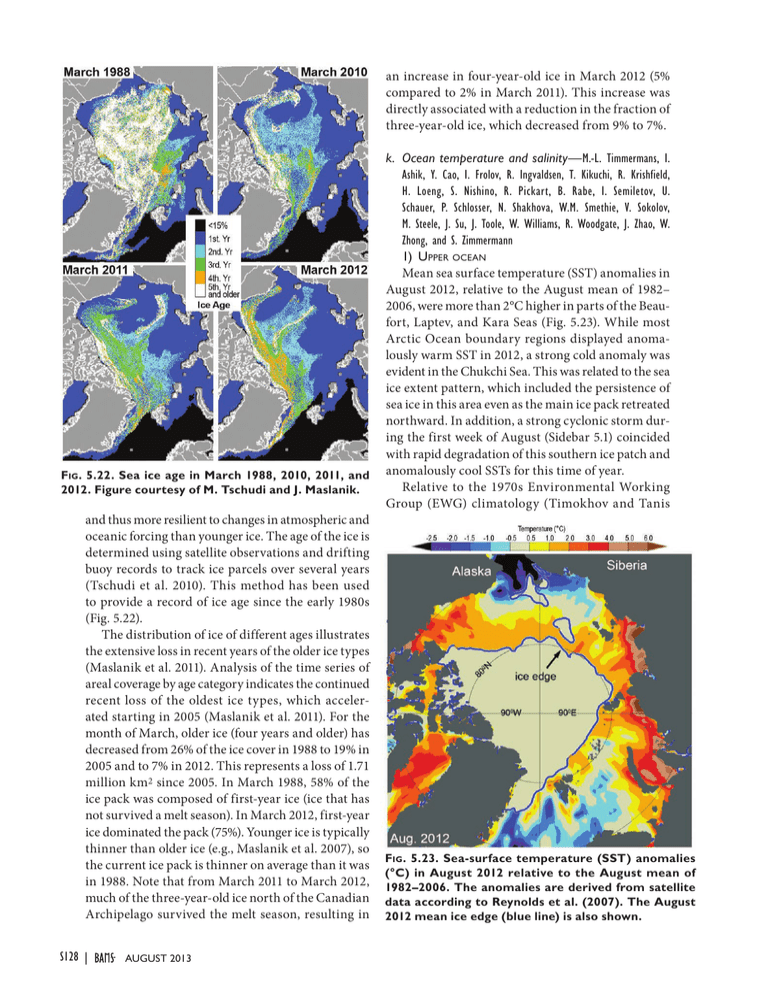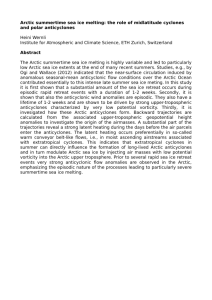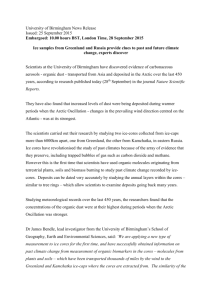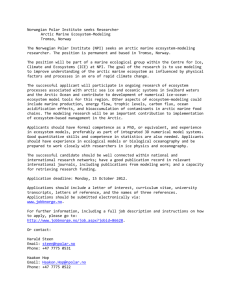an increase in four-year-old ice in March 2012 (5%
advertisement

an increase in four-year-old ice in March 2012 (5% compared to 2% in March 2011). This increase was directly associated with a reduction in the fraction of three-year-old ice, which decreased from 9% to 7%. FIG. 5.22. Sea ice age in March 1988, 2010, 2011, and 2012. Figure courtesy of M. Tschudi and J. Maslanik. and thus more resilient to changes in atmospheric and oceanic forcing than younger ice. The age of the ice is determined using satellite observations and drifting buoy records to track ice parcels over several years (Tschudi et al. 2010). This method has been used to provide a record of ice age since the early 1980s (Fig. 5.22). The distribution of ice of different ages illustrates the extensive loss in recent years of the older ice types (Maslanik et al. 2011). Analysis of the time series of areal coverage by age category indicates the continued recent loss of the oldest ice types, which accelerated starting in 2005 (Maslanik et al. 2011). For the month of March, older ice (four years and older) has decreased from 26% of the ice cover in 1988 to 19% in 2005 and to 7% in 2012. This represents a loss of 1.71 million km2 since 2005. In March 1988, 58% of the ice pack was composed of first-year ice (ice that has not survived a melt season). In March 2012, first-year ice dominated the pack (75%). Younger ice is typically thinner than older ice (e.g., Maslanik et al. 2007), so the current ice pack is thinner on average than it was in 1988. Note that from March 2011 to March 2012, much of the three-year-old ice north of the Canadian Archipelago survived the melt season, resulting in S128 | AUGUST 2013 k. Ocean temperature and salinity—M.-L. Timmermans, I. Ashik, Y. Cao, I. Frolov, R. Ingvaldsen, T. Kikuchi, R. Krishfield, H. Loeng, S. Nishino, R. Pickart, B. Rabe, I. Semiletov, U. Schauer, P. Schlosser, N. Shakhova, W.M. Smethie, V. Sokolov, M. Steele, J. Su, J. Toole, W. Williams, R. Woodgate, J. Zhao, W. Zhong, and S. Zimmermann 1) UPPER OCEAN Mean sea surface temperature (SST) anomalies in August 2012, relative to the August mean of 1982– 2006, were more than 2°C higher in parts of the Beaufort, Laptev, and Kara Seas (Fig. 5.23). While most Arctic Ocean boundary regions displayed anomalously warm SST in 2012, a strong cold anomaly was evident in the Chukchi Sea. This was related to the sea ice extent pattern, which included the persistence of sea ice in this area even as the main ice pack retreated northward. In addition, a strong cyclonic storm during the first week of August (Sidebar 5.1) coincided with rapid degradation of this southern ice patch and anomalously cool SSTs for this time of year. Relative to the 1970s Environmental Working Group (EWG) climatology (Timokhov and Tanis FIG . 5.23. Sea-surface temperature (SST) anomalies (°C) in August 2012 relative to the August mean of 1982–2006. The anomalies are derived from satellite data according to Reynolds et al. (2007). The August 2012 mean ice edge (blue line) is also shown. pathways also influence BG freshwater (Morison et al. 2012), while freshwater transported offshore during storms in the southern Beaufort Sea can also account for a significant fraction of the observed year-to-year variability in freshwater content of the BG (Pickart et al. 2013). The BG heat content in 2012 (see Timmermans et al. 2012, figure 2.11) also remained approximately comparable to 2011 conditions, with ~25% more heat on average in the summer compared to the 1970s. 2) ATLANTIC WATER LAYER Warm water of North Atlantic origin, lying below the halocline at depths between about 200 m and FIG. 5.24. (a) Anomalies of salinity at 20-m depth in 2012 relative 900 m (shallower in the vicinity of to 1970s climatology. Contour lines show the 500-m and 2500-m Fram Strait), is characterized by temisobaths. (b, c) Freshwater content (m) calculated relative to a refperatures >0°C and salinities >34.5. erence salinity of 34.8: (b) freshwater content in the Arctic Ocean based on 1970s climatology (Timokhov and Tanis 1997); (c) freshwa- In 2012 in the southern Barents Sea, ter content in the Beaufort Gyre (the region enclosed by the black Atlantic Water temperatures reached box in the top panel) based on hydrographic surveys (black dots a maximum (since 1951) of up to 6°C, depict station locations) in 2012. about 1.4°C higher than the long-term mean (1951–2010) and about 1.2°C 1997), the major upper-ocean salinity differences higher than in 2011 (Trofimov and Ingvaldsen in 2012 (Fig. 5.24a) were saltier waters in the central 2012). In other regions, no significant changes were Eurasian Basin and a fresher Canada Basin in general. observed in 2012 in this layer compared to 2011 The upper waters of the Barents and Kara Seas were conditions. Relative to 1970s climatology, maximum predominantly anomalously salty relative to climatol- Atlantic Water temperature anomalies are highogy, although the magnitude of the salinity difference est on the Eurasian side of the Lomonosov Ridge, was smaller than in the central Arctic Basin. In the re- with maximum anomalies 2°C in Fram Strait (see gion to the north of Greenland and Ellesmere Island, Proshutinsky et al. 2012, figure 5.22b). Warming is upper-ocean salinity in 2012 was only slightly less less pronounced in the Canada Basin, with Atlantic than the 1970s climatology, although small changes Water cooler now than in the 1970s in the region to can be attributed in part to gaps in sampling. the north of Ellesmere Island. The maximum freshwater content anomaly is centered in the Beaufort Gyre (BG), Canada Basin (Fig. 3) PACIFIC WATER LAYER 5.24c). The BG accumulated more than 5000 km3 of The Pacific Water layer in the Arctic Ocean freshwater during 2003–12, a gain of approximately originates from the Bering Strait inflow and resides 25% (update to Proshutinsky et al. 2009) relative to in the Canada Basin at depths between about 50 m climatology of the 1970s (Fig. 5.24b). In 2012, the BG and 150 m. Data from ice-tethered profilers that freshwater content was comparable to that in 2011, sampled in the central Canada Basin during 2004–12 although 2012 saw a shift in the center of freshwater indicate Pacific Water warming in recent years that content to the northwest relative to 2011, consistent is broadly congruent with freshening. The maximum with the large-scale wind forcing (see Timmermans temperature of the Pacific Water layer increased by et al. 2012, figures 2.7, 2.11). The strong freshwater about 1.5°C over this time, with corresponding inaccumulation trend in the Beaufort Gyre has been creases in heat content. linked to an increase in strength over the past decade In 2011, the most recent year for which data are availof the large-scale anticyclonic wind forcing (e.g., able, Pacific Water inflow through the Bering Strait Proshutinsky et al. 2009). Shifts in major freshwater was about 1.1 Sv (Woodgate et al. 2012), significantly STATE OF THE CLIMATE IN 2012 AUGUST 2013 | S129 greater than the climatological value of about 0.8 Sv (Roach et al. 1995). The 2011 Bering Strait heat flux (~5 × 1020 J relative to -1.9°C, the freezing point of Bering Strait waters) was comparable to the previous record high in 2007. The freshwater flux through the strait (relative to a salinity of 34.8) indicates the 2011 annual mean is 3000 km3–3500 km3 (Woodgate et al. 2012), roughly 50% greater than 2001 and 2005 values. The interannual variability of the freshwater flux through the Bering Strait is larger than the interannual variability in the other major freshwater sources to the Arctic, i.e., rivers and net precipitation. l. Ocean acidification—J. T. Mathis, C. Hauri, and J. N. Cross It has been widely shown that the uptake of anthropogenic CO2 by the oceans (e.g., Sabine et al. 2004, 2007) has a significant effect on marine biogeochemistry by reducing seawater pH (e.g., Feely et al. 2009; Caldiera and Wickett 2003) and the saturation states (Ω) of important calcium carbonate (CaCO3) minerals (Feely et al. 2004; Orr et al. 2005; Caldiera and Wickett 2005) through a process termed “ocean acidification”. However, the uptake of anthropogenic CO2 is not the only process that can reduce Ω. There are several SIDEBAR 5.2: TOWARD AN INTERNATIONAL NETWORK OF ARCTIC OBSERVING SYSTEMS—C. M. LEE, J. ZHAO, AND M. JAKOBSSON Arctic environmental change, exemplified in this chapter, motivates research and observations to quantify secular trends, understand the driving mechanisms and feedbacks, and improve predictability of both Arctic change and its impact on global climate. Local needs also drive observing activities, as Arctic residents, government, and industry require information over a range of timescales to inform their response to the changing environment. An integrated international network of Arctic observing systems (AOS), spanning a broad range of spatial and temporal scales and providing the multiyear persistence required to resolve secular trends, is needed to meet these varied demands. The pan-Arctic scope and decadal outlook define a broad, inherently international, network of observing systems. An AOS must provide data to meet needs that fall under three overlapping domains, loosely termed policy, strategy, and tactics. Policy ties closely to governance, demanding an understanding of environmental change to inform long-term planning (decades), disaster mitigation (prevention and preparedness, response, recovery), regulation, and environmental protection. Value is placed on long records compiled from sustained, consistent measurements distributed around the Arctic. At the strategy level, government, industry, and local communities require data to carry out medium-term planning (seasons to years) of expensive or hazardous activities. Examples include assessing feasibility of shipping across the Arctic Ocean and engineering to support resource extraction. Data needs can be more geographically localized than those of the climate network, and strategy-level observing systems may exist at both national and international scales. Tactical needs involve the supply of data products to answer short-term (hours to weeks) requirements, such as guiding safe, efficient travel and informing hunting and fishing activity. This demands real-time delivery and may involve highly localized systems driven at the community level. S130 | AUGUST 2013 This conceptual framework guides the design and development of a broad range of Arctic observing systems and their coordination into a broader, sustainable network. While challenging in scope and longevity, a nested, network-of-systems structure allows individual components to be planned and executed at tractable scales. This approach also facilitates implementation of flexible systems capable of evolving in response to environmental challenges and shifting priorities. Significant effort has been invested in planning for an AOS. For example, the Study of Environmental Arctic Change (SEARCH 2005), the U.S. Polar Research Board (2006), and Interagency Arctic Research Policy Committee (IARPC 2007) discuss potential U.S. contributions to a pan-Arctic observing network. The Arctic Ocean Science Board (AOSB 2005) outlined an international plan for integrated Arctic observing during the IPY 2007–2008. More recently, the Arctic Regional Ocean Observing System provides an example of international integration, with institutions from nine European countries integrating diverse observational and modeling efforts to provide operational monitoring and forecast capability (http://www. arctic-roos.org). The International Study of Arctic Change (ISAC 2009) facilitates cooperative, international efforts to understand the future state of the Arctic, while the Sustained Arctic Observing Network (SAON; http://www.arcticobserving.org) seeks avenues for international collaboration, governance, and support of observing activities. A biennial Arctic Observing Summit (a contribution to SAON), first held in May 2013, serves as a forum for planning and coordinating network activities, and for identifying approaches for overcoming pannational challenges. In broad terms, an AOS would consist of distributed observing networks, flagship observing sites, and hybrid systems. Distributed networks, such as the International Arctic Buoy Programme, collect key measurements at a large number of sites, typically with broad, pan-Arctic or regional coverage.





